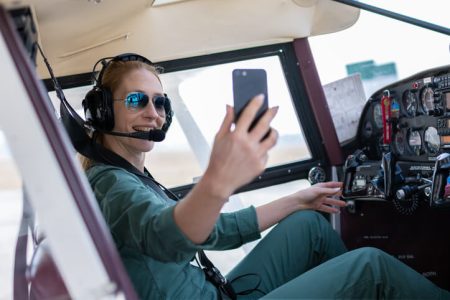The NTSB Recommends Changes to FAA Regulations Regarding PEDs
The use of personal electronic devices for nonoperational purposes is becoming a critical safety concern in aviation. The NTSB has recommended that the FAA regulations change to prohibit the use of such devices in Part 135 and 91 aircraft to address this growing threat to safety. According to the NTSB, “Distraction is a growing life-threatening problem in all modes of transportation.” It is imperative for all aviation professionals to prioritize attention and adhere to safety protocols to prevent tragic incidents caused by distractions during flight operations.
The use of personal electronic devices (PEDs) in aviation has become a hot topic in recent years. With the rise of smartphones, tablets, and other devices, pilots and flight crew are increasingly bringing these devices into the cockpit. While they can provide convenience and efficiency in certain situations, PEDs also pose a significant distraction risk to flight operations.
Distractions caused by PEDs can come in various forms, such as checking social media, texting, or browsing the internet during critical phases of flight. These distractions can divert a pilot’s attention away from their duties and compromise situational awareness, leading to errors or even accidents.
In response to this growing threat to safety, the NTSB has recommended that the FAA regulations prohibit the use of PEDs for nonoperational purposes in Part 135 and 91 aircraft. This recommendation is based on several incidents where the use of PEDs played a significant role in fatal accidents.
While some may argue that personal electronic devices have become an essential part of daily life, it is crucial to prioritize safety in aviation operations. Aviation professionals must understand the potential consequences of PED distractions and prioritize attention to ensure safe flight operations.
In addition to implementing regulations, it is also essential for aviation organizations to have strict policies in place regarding the use of personal electronic devices during flight. Pilots and flight crew should adhere to these policies and set a good example for others by avoiding distractions caused by PEDs.
Ultimately, safety should be the top priority for all aviation professionals. By recognizing the dangers of PED distractions and taking necessary precautions, we can prevent tragic incidents and ensure safe flights for everyone on board.
Sterile Cockpit Rule
Sterile Cockpit Procedures are in effect during critical phases of flight, typically below 10,000 feet during takeoff and landing, and any other times of high workload or when instructed by the captain. During these times, activities that are not directly related to the safe operation of the aircraft are prohibited. This includes non-essential conversations among crew members, eating, reading materials unrelated to the flight, and any distractions that could divert attention from flying duties.
Reasons for Following Sterile Cockpit Procedures
- Avoiding Distractions: The primary goal of a sterile cockpit is to minimize distractions that could detract from the crew’s focus on operating the aircraft and monitoring its systems during the most critical and high-workload parts of the flight.
- Minimizing Risks: By eliminating unnecessary distractions, pilots can significantly reduce the risk of errors that could lead to accidents or incidents.
- Improving Communication: With non-essential chatter ruled out, communication becomes more efficient and focused on flight operations, ensuring that important information is clearly conveyed and understood.
- Enhancing Situational Awareness: A sterile cockpit allows pilots to maintain heightened awareness of their environment, including other aircraft, weather conditions, and their aircraft’s performance.
- Ensuring Compliance with Regulations: Following sterile cockpit rules is not optional; it’s a regulatory requirement. Compliance is necessary for legal and safety reasons.
- Facilitating Decision Making: In critical situations, the ability to make quick, informed decisions is vital. A distraction-free environment supports better decision-making.
- Promoting Professionalism: Adhering to sterile cockpit procedures reflects a commitment to professionalism and respect for the responsibilities of piloting.
- Learning from Past Mistakes: Numerous accidents and incidents have been attributed to distractions during critical phases of flight. Learning from these mistakes is essential for improving safety.
In 2021, a young pilot was flying on a low-level pipeline patrol in a Cessna 182. During the flight, he was taking pictures and then immediately posting them on snapchat. Right after his last post, he hit the guy wire of a radio tower which sheared off the left wing and sent the aircraft diving into the ground, where it burst into flames.
The 23-year-old pilot was killed instantly. According to the NTSB final accident report, the pilot was likely distracted while using his mobile device and did not maintain an adequate lookout to avoid known obstacles.
It all comes down to situational awareness and how it’s so incredibly easy to lose when you are not focused on the task of flying the airplane. Whether you are flying a Cessna 150 or a Boeing 787, the FAR regulations are the same. Put your phones down and fly the plane.
RELATED CTS TRAINING









